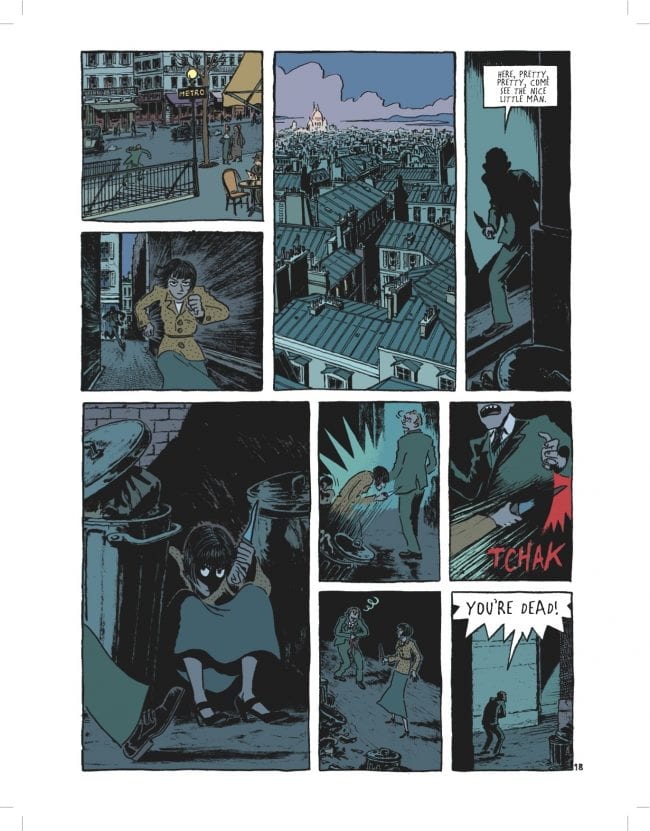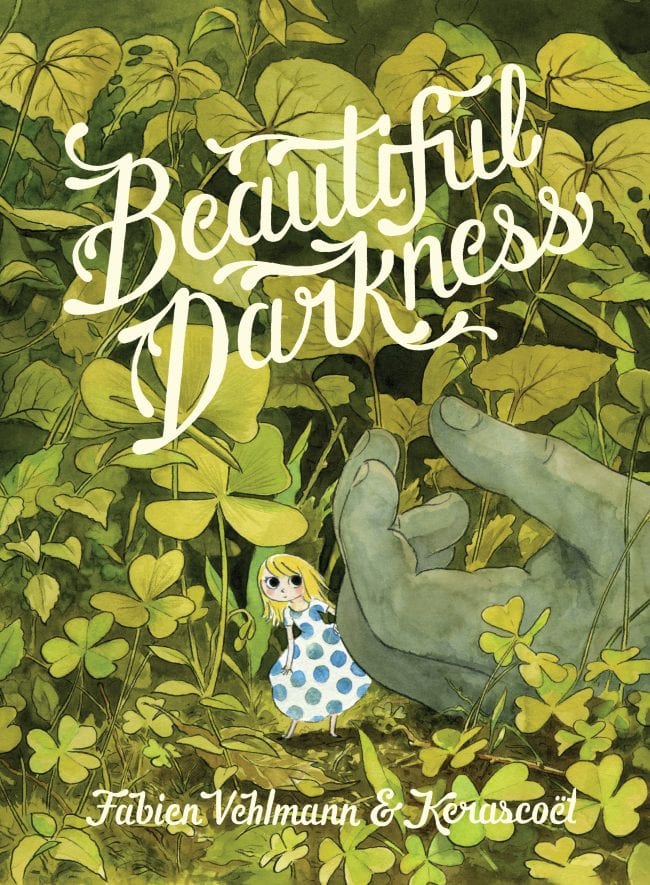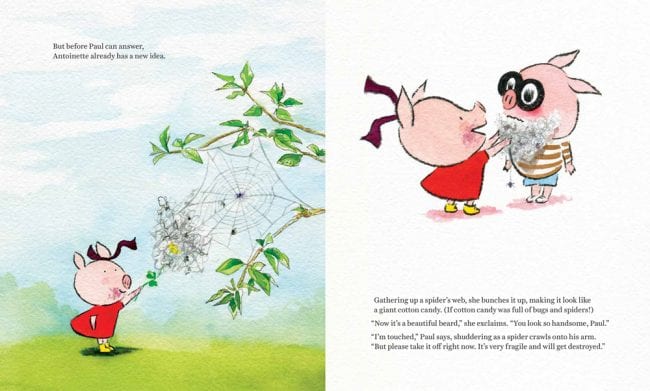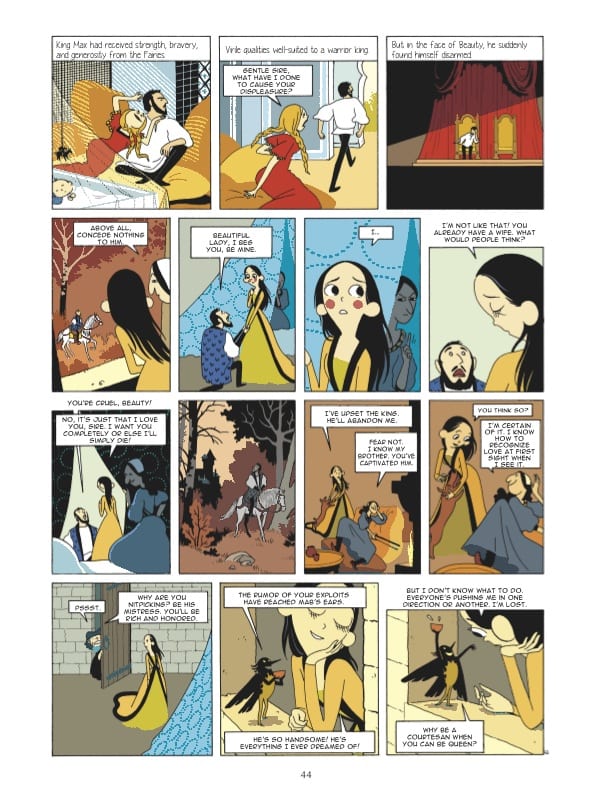 In recent years Kerascoët has established themselves as one of the great cartooning teams working today. The husband and wife duo of Marie Pommepuy and Sébastien Cosset have created a number of books including two volumes of Dungeon: Twilight and the four book series Miss Don’t Touch Me, which NBM collected in a single volume. In 2014, NBM published Beauty and Drawn & Quarterly published Beautiful Darkness, two very different books, both of which were among the best books published in North America that year.
In recent years Kerascoët has established themselves as one of the great cartooning teams working today. The husband and wife duo of Marie Pommepuy and Sébastien Cosset have created a number of books including two volumes of Dungeon: Twilight and the four book series Miss Don’t Touch Me, which NBM collected in a single volume. In 2014, NBM published Beauty and Drawn & Quarterly published Beautiful Darkness, two very different books, both of which were among the best books published in North America that year.
The two recently visited the United States, where among other things they saw the release of their first children’s book, Paul and Antoinette. It was also just announced that among their many upcoming projects, the pair will be illustrating Malala’s Magic Pencil, a children’s book written by Nobel Peace Prize winner Malala Yousafzai, which will be released next year.
The first thing I read of yours, the first comic published here in the United States, was Dungeon: Twilight. Was that first comic you made?
Marie: We started Dungeon and Miss Don’t Touch Me at the same time.
When did the two of you start working together?
Marie: We met in art school and we started at the end of our studies. We lived in a very small space. We only had one desk and so we started working together we couldn’t switch from one thing to another. We heard about a contest to be published and we only had two weeks. We didn’t ask ourselves how to do, we just jumped.
How do you work? Do you both pencil, ink, and color?
Marie: Yes.
Sébastien: We don’t draw the same but we are complimentary.
Marie: We don’t have the same style.
Sébastien: We don’t separate the work–sketches, inking–like comic book artists sometimes do. It’s more like in animation or some Japanese manga-ka. She works essentially with the characters. I mostly do the backgrounds and things like that. But she also makes the mise-en-scéne, the storyboards, sketches, inking, coloring. It’s always different with each project because we don’t draw with the same style.
Marie: And we change our process.
Artistically, your books are similar, but they each have a distinct look.
Marie: Yes we try to change our tools and our process from one project to another. We like to explore different things. We don’t think about style, but it comes from us so there’s the style. Most important for us is to have a book that is coherent.
Sébastien: When we start a project we make our own rules and constraints. We play with the rules, like playing a game, but we know the rules of the game. When it’s done we move to another thing. We want to always be surprised by our own drawings and process. When we do the same thing for a year it becomes a routine and we don’t want this.
How do you decide what projects to do?
Marie: It’s hard to agree.
Sébastien: It’s harder and harder
Marie: It needs to have meaning and it has to be important for us. We need to have something to tell. Not to just make a book to make a book.
Sébastien: At the beginning, a lot of it was from meeting people. We met Hubert and we wanted to do something with him. We talked about what all of us wanted to do together. Our projects are always collaborations so it’s not that someone is writing the story and then after gives us the story for us to draw. We work at the beginning with the idea of the project and what we want to do together.
Marie: As a team
You enjoy complicated narratives.
M&S: [laughs]
Sébastien: Not so complicated.
Marie: We like when stories are intense and very full. I don’t know how to say it. There’s a lot of panels, for example. We want big stories. Dense.
You like stories that are dense and they’re big, but I think about Beauty which kept moving in different directions and it was huge but also intimate.
Sébastien: In France it’s three books, so when you read the three of them together it’s big.
Marie: As a reader or spectator, I like to be lost. I don’t like to know what’s going on. I’m for me one of the best movies is Mulholland Drive because I don’t know what I watched. That’s the best thing. You go out of the movie and you want to go back to be in the movie. It’s still with you when it’s over. You carry it with you. That’s what I like in fiction.
 One example of that would have to be Miss Don’t Touch Me, which is four books, and the mystery that sets the plot in motion is solved and resolved at the end of the second book.
One example of that would have to be Miss Don’t Touch Me, which is four books, and the mystery that sets the plot in motion is solved and resolved at the end of the second book.
Marie: For us the characters are very alive. With Miss Don’t Touch Me, the character is a real person and we wanted to know what’s happening to her after everything.
Sébastien: When we talk about her, we talk like she’s somebody we really knew.
 You’re also not afraid to go to dark places. I think everyone who read Beautiful Darkness was shocked by it.
You’re also not afraid to go to dark places. I think everyone who read Beautiful Darkness was shocked by it.
Sébastien: It’s probably the most intimate book we made because it was Marie’s idea in the first place. We worked with Fabien Vehlmann together because we had so many common ideas and thoughts that we wanted to put in the story. It’s about childhood and death and a lot of stuff. And innocence, I think.
Marie: But there’s a comic part in it. You can laugh at it, too.
Sébastien: It was our strange sense of humor.
Where did the idea start originally?
Marie: I made a lot of sketches. I knew how to start the story. The first ten pages were very clear in my head. Then I met Fabien Vehlmann and we talked a lot about the story and it echoed in his work. It’s very funny. It’s about depression, but in a funny way. [laughs] He’s a very funny guy. When I talked to him about my story I told him I can’t draw it because it’s so depressing but when I told him about the sketches and he looked at them, he was laughing. I was so surprised. So the three of us started to work together.
 Beautiful Darkness has a much more painted, lush style. You had that in mind from the start?
Beautiful Darkness has a much more painted, lush style. You had that in mind from the start?
Marie: Yes, that’s what we wanted. We wanted to be in nature and paint nature and have fun with it. We just finished Miss Don’t Touch Me and there’s a lot of backgrounds that are not funny to draw like buildings and cars.
Sébastien: There was a lot of research.
Marie: Lots of research. We live in Paris, but we wanted to feel nature and the seasons.

 Your publisher sent me a copy of your new children’s book, Paul and Antoinette. How did this come about?
Your publisher sent me a copy of your new children’s book, Paul and Antoinette. How did this come about?
Sebastian: We started to work with Kirsten Hall of Catbird Agency in New York. She contacted us a few years ago. She was building her own little agency and she looked all over the world for people she wants to represent in the US. So we said, okay, why not.
Marie: She showed our art book to Claudia [Zoe Bedrick] and she fell in love with a character we made a few years ago–this pig with the big glasses. She asked us to make a story about him and that’s how it started. We want to make more and more children’s books. For me it’s the holy grail of fiction. I’m so happy to see it.
So you had Paul and then gave him a sister.
Marie: Yes, she said how about make a couple? We thought a strange couple. He looks very clean and strict and so we gave him a sister. [Sebastian] has a sister and I have a brother and when you are two you are very different roles. As a child my brother had glasses and was strict and everything was perfect in his room. I went to his room when he wasn’t there and just opened the door and closed it and when he came back he knew I had opened the door. I don’t know how because I didn’t touch anything. I liked gross things a lot. I ate the grease, the disgusting part of the meat, just to watch him react. I loved the pleasure of watching him react.
Sébastien: It’s also a way to talk about accepting different people, and accept that people who aren’t like you can bring you something else in your life.
Marie: I’m so happy with what she did with the book. It’s a beautiful book.
I gave the book to a few people to read who commented that they liked how the typical gender dynamic–that the girl would be neat and the boy would be messy–was flipped.
Marie: Thank you.
Sébastien: Most of our characters are female. We like strong female characters. Like Miyazaki.
Strong characters and complicated characters.
Sébastien: Yes, Blanche in Miss Don’t Touch Me lived through a very difficult thing–her sister killed in front of her–and for us it’s very important that the characters always bring what they experienced in and after they don’t forget it. Sometimes in fiction [characters] live through a horrible thing and two minutes after it’s like, woo! Everything’s cool. I just lost my mother, my sister, my hometown but I’m great. For us, no, it’s not possible. She just lived through something awful. Even if after something nice happens, she’s always affected by this. We were talking a lot with Hubert because sometimes he made her do things and we would say, she wouldn’t do that because she’s not a victim. She will take the best of it and she will fight. When we draw we are always in the heads of the characters. Even when they are pigs.
I did especially love the ending of Beauty, because it really made this point about the nature of beauty.
Sébastien: It was a long process. If we had to write the end of the book when we were just starting the project, it wouldn’t be like that. It was the result of all the things that we did. We were very happy because Hubert’s first ending was dark and there was lot of death and we didn’t want that. We said, we did that, now we need a happy ending. What’s wrong with a happy ending? They fall in love and they are meant to be together so don’t fight against it. He agreed. It was against his nature at the beginning, but at the end he was very happy with it. We were very happy. But it was a fight. [laughs] We don’t want to always make the same kinds of things. If you want to surprise people you have to sometimes think differently.
 Beauty was the most recent comic that you’ve made which has been translated but I know that you’ve made other books since then.
Beauty was the most recent comic that you’ve made which has been translated but I know that you’ve made other books since then.
Marie: We had a book that just came out called Satanie.
Sébastien: With Fabien Vehlmann.
Marie: It’s about a group of people who go into the ground and go too far and they arrive in hell. It’s funny, too. [laughs]
Sébastien: It’s like an adventure story. A road movie, but a road movie in the ground. It’s also a psychological story about what’s happening in the characters’ brains.
Marie: The deeper they go, the more they know about themselves
Sébastien: They’re struggling with their own demons but also real demons. [laughs]
Marie: I’m working on a strange ABC in France with a friend. That’s my next book. It’s a strange ABC with phrases with all the words starting with the same letter. All the letters are like that. The translation has been very difficult. It’s difficult to make it work in French and English.
Marie: We have a lot of projects. We are making another children’s story in France. We are working with a French theater to make children’s books from short plays.
Sébastien: We also have a project in animation with Benjamin Renner who was the director of Ernest and Celestine. We’re working on an adaptation of Les Tchouks, the children’s books we made in France. We’re trying to adapt it for an animated TV show.
Thanks to Alix de Cazotte, Program Officer at the Cultural Services at the French Embassy, for arranging the interview.







